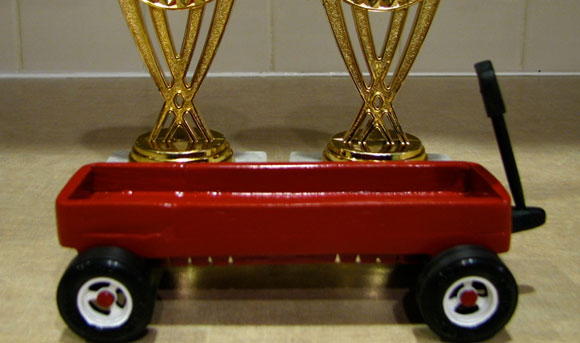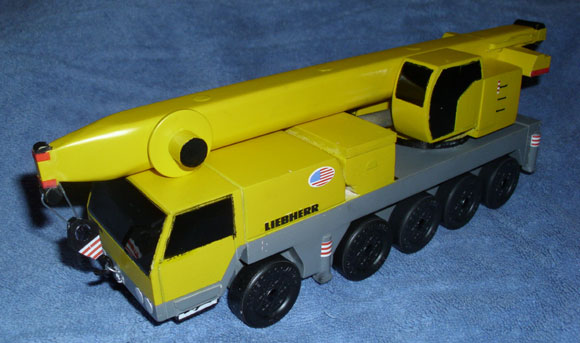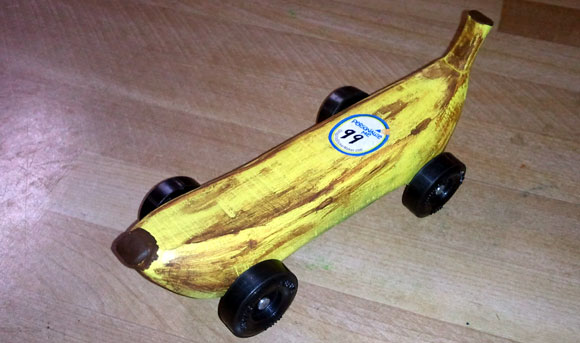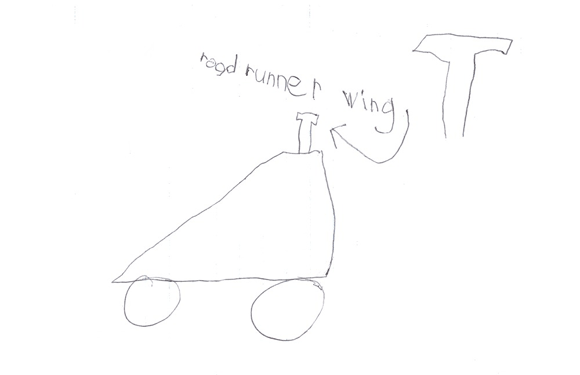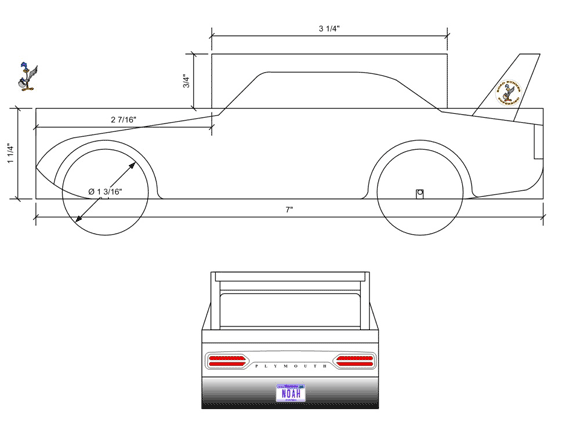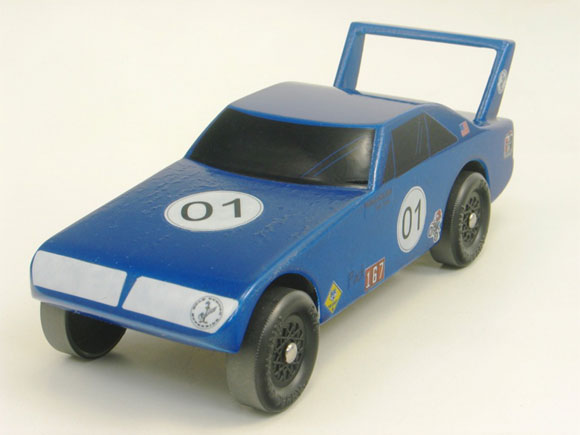– Feature Article – Leader Help: How Much is Too Much?
– Pinewood Derby Car Showcase
– Memory – The Plymouth Superbird
– Q&A
Leader Help – How Much is Too Much?
(An update of an article originally published Volume 2, Issue 9 – January 22, 2002)
The purpose of this article is to discuss the appropriate level of involvement by leaders in assisting car owners. The child (or child/parent team) is the car owner and should be responsible for their own creation. But sometimes overzealous leaders step in too quickly and off-load some of that responsibility.
My Experience
To set the stage, let me first share excerpts from our past derbies.
My first involvement in assisting with the pinewood derby at our local club was helping at the weigh-in. At that time, a man brought along a drill, a propane touch, and a bunch of lead tire weights, and proceeded to add weight to light-weight cars. Drill a hole, melt some lead(1), next car …
At the time it seemed like a good idea to me, so the next year I took over that job. Drill a hole, melt some lead, next car … . However, things quickly turned sour.
Some of the cars weighed virtually nothing, so many holes were needed. Inevitably, some of the holes went all the way through the car, resulting in fierce glares from the parents. In other cases, the lead burned the paint job. This is not to mention the burns on my hands (and likely a reduced life expectancy due to lead inhalation!).
I was at my wit’s end by the end of the night, and the last car was the final straw. A mom brought in a car that needed about an ounce of weight. I drilled a hole, melted some lead, and weighed the car. 4.9 ounces. Not good enough for this mom. So, drill another hole, melt more lead, 5.1 ounces. Remove some lead. 5.0 ounces. Finally the lady was satisfied, and I had had enough.
I realized that I was performing an integral part of building the cars (adding the proper amount of weight) for most of the car owners in the club. Not only was I doing that in a crude (and dangerous) way, but the child/parent team had come to expect that this is the way it should be, and were off-loading part of the car building responsibility to the club and myself. If the car did not perform well, they could always rationalize, “Oh well, that guy at the weigh- in must have not weighted the car properly.”
Why was our club taking on part of the car building responsibility? I decided it was time to make a change. I had a discussion with our club leader. He was at first reluctant to change things, but we finally reached an agreement. I would write a booklet explaining how to build a car (including proper weighting), which would be distributed with each car kit. In exchange, the club would no longer provide a weighting service at the weigh-in.
Fast forward to next year. In every flier and announcement it was made clear that the club would not provide weight for underweight cars; the child/parent team were expected to take care of this important aspect of car building. Of course only about half the parents read the information, so many were upset when they showed up at the weigh-in and didn’t have any method to add weight to their cars (a lot of pennies were used that year).
The next year, fewer parents expected the club to weight their cars, and most brought weight and adjusted the weight themselves. At the subsequent year’s weigh-in it was clearly understood by everyone that the child/parent team were responsible for their own car. In a few instances, I (or another parent) did provide some assistance. But most of that was eliminated because of the workshops held on preceding Saturdays.
Child/Parent Ownership
The basic premise of the pinewood derby is that the child/parent team is responsible for their car. They should design it, build it, and race it. Club or organization leaders should avoid (as much as possible – see below) participating in the building of the car. Why? Here are a few reasons:
- The car owners need to be responsible for their own work. No one else can, nor should be held responsible for their level of success (or lack of).
- Car owners that chose to do very little to their car could end up winners if a leader with excellent car building skills stepped in and reworked the car at the weigh-in. This would certainly be unfair to other car owners.
- Leaders that step in and weight, lube, or adjust cars can easily damage a car. Trust me; this is not a situation you want to be in.
Weigh-In No-Nos
In addition to weighting the car, race leaders can easily fall into the trap of assisting in other car building areas at the weigh-in.
Lubrication
The most common area is lubrication (or rather lack-of lubrication). No matter how much information is provided to parents, cars will still show up at the weigh-in without lubrication. Leaders, don’t grab the car and lubricate it! Instead, offer a spare tube of graphite, direct them outside (or to the designated lubrication area), and let them have at it – a tip on how to lubricate is certainly okay.
Wheels/Axles
Another area to avoid is fixing catawampus(2) wheels. Many times cars will arrive at the weigh-in with wheels that are inserted at odd angles, falling out, or covered with paint or glue. If needed, offer a new (unprepared) set of wheels/axles, glue, and/or advice, but let the car owners fix the problem.
Out of Spec Car Bodies
Several times I have seen cars show up that are too long, too tall, too low, or out of specification in some other way. Share this information with the car owner, give a suggestion on how to correct it, and then step aside.
Exceptions
Of course there are exceptions to every rule.
Workshops
Workshops are held so that the child/parent team can have access to tools and expertise that they might not have. It is certainly appropriate for club leaders to assist the child/parent team at these events. But assistance should be mostly limited to coaching. Show the car owners how to perform the step, and then let them do it (with the exception of major power tools). People learn best by doing, not by watching.
“Hardship” Cases
There are sometimes cases where a child cannot get the parental assistance they need (for whatever reason). Certainly it is appropriate for a leader (or another parent) to step in and provide assistance in these cases.
Catastrophes
If a catastrophe happens, (e.g., a car owner drops and breaks the car at the weigh-in) rendering assistance is certainly appropriate. A similar case is when a child car owner is at the weigh-in without their parent, and the child is not able to correct the problem.
Conclusion
The key point is that children (and oftentimes parents) need to learn responsibility. Leaders that are too quick to help can keep the car owners from learning this important lesson.
(1)As I indicated in the article, melting lead is a dangerous practice. We strongly urge you to avoid this practice.
(2)One of my father’s favorite words, meaning “askew” or “off- kilter”.
Pinewood Derby Car Showcase
Some pinewood derby cars that aren’t cars.
Little Red Wagon – Jeremy Isaac
This was my daughter’s car for the AWANA Grand Prix this past year. It placed 3rd in Speed and 1st in Novelty.
Liebherr LTM 1095 5.1 Mobile Crane – Robert Knapp
As a scout leader I like to show the boys what is possible with a block of wood. I got my inspiration for this year’s car when I passed one of these driving on the interstate. The boys loved it! I could not count the times I heard the word cool!
Banana Mobile – Christine DuVal
This is the “Banana Mobile” that I made for the leaders race at our Awana Grand Prix earlier this month (January 2011). I made it for fun, not for speed, but I was pleasantly surprised at how well it did! It beat pretty much all other cars except for a few wedges that were definitely built for speed. And to answer the question I know you are dying to ask… No, I did not have help from my husband, I did it all myself 🙂
Pinewood Derby Memory
The Plymouth Superbird
What started out as a block of wood turned into a huge tradition. When I was in first grade my family decided to have me join Cub Scouts. I liked it, but I really started to enjoy it when we were able to make Pinewood Derby cars. The Pinewood Derby is a race of model cars made out of a block of pinewood. My dad and I decided to create a car that was fast, but also looked good. My dad and I each drew up our own plans to make a car we both thought would win. We combined them together to make what we thought, was the perfect plan. Now the real work of building this car began.
We went down to my dad’s shop with the block of wood and our huge plan. First we drew out the plans and decided to make a Plymouth Superbird, which is one of the fastest race cars ever. Once we started to cut and sand the piece of wood, we could see it begin to come to life. The Metallic Fleck Blue paint transformed this piece of wood, into a model car. The only thing left was to put in the fine details to make it look like a real racing car. My dad made sponsor decals and I arranged them on the car. We painted the number “01” on the side and hood of the car. The trickiest part was to put the decal windows on the model. Big decals are harder to place, since they like to roll up. I was happy this part went well. Now it was off to the races.
The day of the race finally came. Once I saw all of the other racers and their cars, I thought I would get last place! I was one of the first four racers to the starting line. I didn’t know who would win this round. To my surprise, I won that round. It felt so cool and I was so proud my car was so fast. The next round came and I won that one too. The races kept going until lunch time and we had to take a break. It was hard to wait to race my car again. There was another ten rounds, before I got to race again. The next two races, I placed second. When the races were complete, I won second place and was able to get my first trophy. The best part was being able to go on to the district races.
Two months later I attended the district race at the Mall of America. There were more than 200 cars racing. My car was not fast enough to win, but I was proud of how excellent I did. It was nice to have the pleasure of knowing, I actually made it to the district races. Good news did come my way when I found out this was a yearly event. This is how the Pinewood Derby tradition started in our family. My dad and I still build cars for fun, even though I am too old to race them as a Cub Scout.
Noah Holzer
Q&A
How easy is it to paint the tungsten canopy that you offer? Do you have to scuff the nickel plating off?
I recommend lightly sanding with 800 grit paper. It should then paint nicely. Mainly you want it to be clean — free of fingerprints or any other substance that would repel paint.
Our BSA pack rules stipulate that the axles cannot be further than 4 5/8 inches apart. With the 4 5/8 inches wheel base constraint, in your experience what is the ideal or best axle location — more forward or more rearward?
On most tracks (slope, transition, flat section), you want the rear axle back as far as possible, and the weight as far back as possible, yet still retaining stability. So I would place the rear axle at 11/16 inch from the back of the car, and then place 1/3 of the added weight behind the rear axle and 2/3 just in front of the rear axle. The final balance point of the car (with wheels on car) should be about 1 inch front of the rear axle.
Do you determine the center of gravity and drill holes for cylinder weights (through the side) before or after you cut out the car and sand it to shape?
I recommend drilling any weight holes while the block is intact. It is much easier to drill holes when you have a full block. You can estimate the amount of weight required by weighing the block, estimating how much of the block will remain after shaping (30, 40, 50 percent or more). Then multiply the weight of the block times the percentage and add 0.5 ounces for the wheels and axles. Subtract this sum from 5 ounces to get the amount of weight required. (See previous question for distribution of weight on the car.) Just make sure to subtract a little to account for paint and any accessories.
Want Answers?
Do you have a pinewood derby-related question? If so, e-mail us your question.We answer all questions by e-mail, but not every question will appear in the Q&A section of the newsletter.
Back Issues
Are you a new subscriber, or have you missed some of the previous newsletters? Don’t miss out; all of the issues for Volume 5 through Volume 17 are posted on our web site.
Newsletter Contributions
We welcome your contributions. If you would like to contribute an article, a web site review, a speed tip, or a pinewood derby memory, please e-mail us.
Subscription Information
The Pinewood Derby Times is a free e-newsletter focused on pinewood derby racing. It is published biweekly from October through March.
If you haven’t already done so, please forward this issue to your pinewood derby friends. But please don’t subscribe your friends. Let them decide for themselves. Thanks.
If this newsletter was forwarded to you, why not subscribe to receive this newsletter. There is no cost, and your e-mail address is safe, as we never sell or share our distribution list.
To subscribe, send a blank e-mail to
[email protected]
You will receive a confirmation e-mail. Reply to the confirmation e-mail and you will start receiving the Pinewood Derby Times with the next issue.
Randy Davis, Editor, Pinewood Derby Times
E-Mail: [email protected]
(C)2018, Maximum Velocity, Inc. All rights reserved. Please do not reprint or place this newsletter on your web site without explicit permission. However, if you like this newsletter we grant permission, and encourage you to e-mail it to a friend.
Maximum Velocity disclaims any personal loss or liability caused by utilization of any information presented in this newsletter.
The Pinewood Derby Times is not specific to, and is not affiliated with the Boy Scouts of America, YMCA, Awana, or any other organization.
(R)Maximum Velocity is a registered trademark of Maximum Velocity, Inc.
(R)Pinewood Derby is a registered trademarks of the Boys Scouts of America.
(R)Awana is a registered trademark of Awana Clubs International.
All other names are trademarks of their respective owners.

